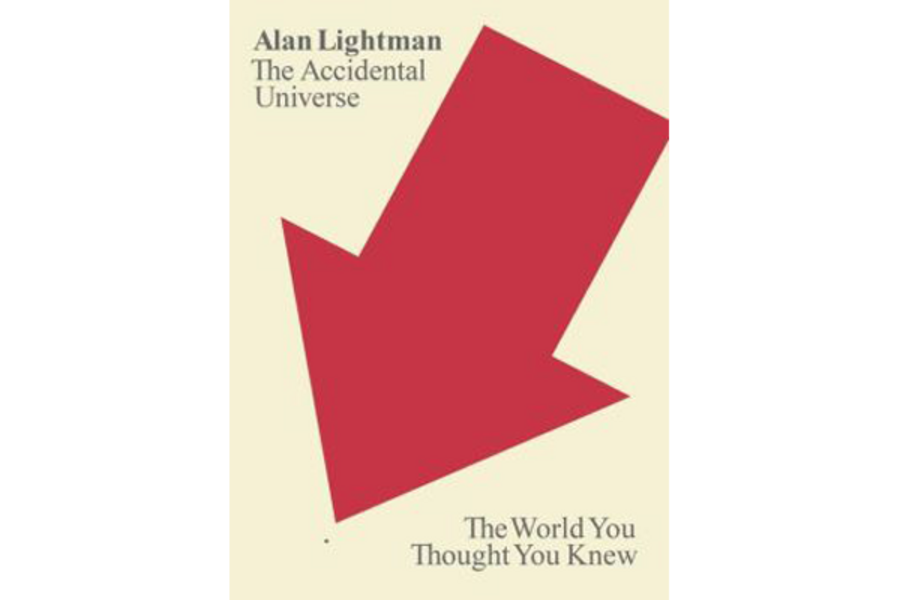The Accidental Universe
Loading...
"I think I can safely say that nobody understands quantum mechanics." Richard Feynman said that 50 years ago, during a lecture at MIT.
How much more inviting can you get? You are about to tell an audience that their senses just aren't up to speed, that the world they see is a far cry from the real story – so playfulness comes in handy. Einstein knew that, as did M. C. Escher, and so does Alan Lightman.
Lightman, as witnessed in his newest collection, The Accidental Universe, is a rare bird: a limpid popularizer of theoretical physics who is comfortable with mystery; someone who can sew the known, the conjectured, and the unknown together like the master needleworker at a cosmological bee.
The seven essays here are of a piece – all deal with some aspect of the universe: symmetry, size, laws, spirit, accident – though they can stand alone and be read in the order of interest. The material, for all its wondrousness, spins and bounces merrily along on the surface, with the occasional dive into deeper waters.
The subjects orbit about recent(ish) perturbations in the field of theoretical physics, with digressions. What has physicists' underwear most in a twist, writes Lightman, is a new player at the table known as the "multiverse."
The notion of the multiverse suggests that there is not just one universe, guided by the Platonic dream of a few principles of symmetry, mathematical truths, and a handful of parameters calling the shots. No, there are many universes, with wildly varying properties generated by the same fundamental principles – some with life, some without, some with 17 dimensions, some with stars, some finite, some infinite.
Thus the laws of nature that govern the behavior of matter and energy, once thought restrictive to a self-consistent universe, are more promiscuous than we imagined.
By now, "eternal inflation" and "string theory" – yes, you have heard of them, but it takes a long while before a theory is welcome in the club – have acquired enough stature to give those Fruit of the Looms a good few twists and a wedgie. "Evidently, the fundamental laws of nature do not pin down a single and unique universe.According to the current thinking of many physicists, we are living in one of a vast number of universes. We are living in an accidental universe. We are living" – heaven help us here – "in a universe uncalculable by science."
At this point, Lightman is just getting under steam. One of the things a multiverse administers is a sharp stick in the eye to the Intelligent Designers. What ostensibly galls them is the very unlikeliness of life in that self-consistent universe, considering the knife edge of improbability for all the complexities of life to line up just so and just for us. Mustn't there have been a guiding hand, a hand that may still be guiding?
"That doesn't matter," writes Lightman. "We live in one of the universes that permits life because otherwise we wouldn't be here to ponder the question" (though H. Allen Orr made the case for evolutionary biology in a self-consistent universe in The New Yorker). On the other hand, writes Lightman, as long as god stays on the sidelines and doesn't monkey about with the laws that govern matter and energy in the physical universe, science can't prove diddly. "Belief is a matter of faith," and those who cut the transcendental impulse short are only cheating themselves.
The chapter on the symmetrical universe sails easefully and economically between the wakes of science and poetry. There are those, and they are not a handful, who believe that the principles of symmetry dictate the existence of all known forces of nature. Symmetries are everywhere, and most of us find them dazzling: the golden section, an iris, the rings of Saturn, an apple's seeds, the sectors of a jellyfish.
If when Lightman introduces the electroweak force things get slippery – "That is, you can exchange some of these particles with the others, and the fundamental forces act in the same way.... The only problem with Weinberg and Salam's proposal is that we know that photons and Ws and Zs are not identical" – nonetheless, this is where we get to meet the Higgs boson, and really, who doesn't think the Higgs boson, name alone, isn't cool? Even better, you leave the chapter with a glimmer of how Higgs boson energy contributes to symmetry and mass. Not a close friend yet, Higgs, but an acquaintance.
Lightman never leaves the mysteries for too long and shares our enjoyment of the strange and singular, surprises and peculiarities. He feels like David Hume: the unruly attractions out there give us "an agreeable emotion." And though he laments our mediated world of the iPhone, he is quick to acknowledge that nowadays our increasing understanding of nature comes not from sensory experience but from instruments and calculations. Still, they feed our hunger for wonders and oddities, knowing there are colors we have not experienced, the glow of a desert we can't make out, all the trillions of things flying about, sometimes existing in two places at once – or nowhere – that pass us by, ships in the night without running lights.
"The architecture of our brains was born from the same trial and error, the same energy principles, the same pure mathematics that happen in flowers and jellyfish and Higgs particles.... It is nonsensical to ask why we find nature beautiful. Beauty and symmetry and minimum principles are not qualities we ascribe to the cosmos." No, "they are simply what is, just like the particular arrangement of atoms that make up our minds. We are not observers on the outside looking in. We are on the inside too."








